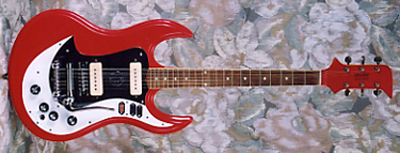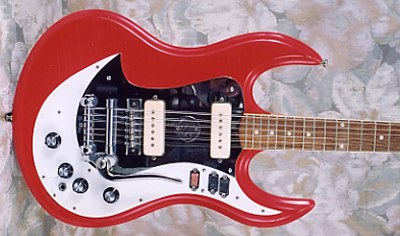Back in the late 1960s—Jimi notwithstanding—the cat’s pajamas of amplifiers were solid-state. Tube amps were heavy and prone to feedback. Solid-state amps were clean, big, and loud. I ran a whole band off a humongous 350-watt Mosrite amp. The mix sucked, but we were loud! The most desirable amps at that time were made by Standel and, to a lesser extent, Kustom (depended on your kind of music). It was only later that I learned that both companies also made guitars, like this ca. 1966 Standel Model 101 Custom Deluxe Solid Body Guitar. Heavy!

Vintage 1966 Standel Model 101 Custom Deluxe Electric Guitar
Fast forward to the go-go ‘80s. Not about stocks or dancing. Go-go because I was buying guitars hand over fist. Weird guitars. Mystery guitars. One of those guitars snared in my trap was this Standel. I held back at first because there was some damage to the pickguard near the jack and I had no idea what this thing was. But plastic can be fixed, right? Once I started looking into this guitar, I was glad I didn’t pass.
Roll the tape further forward and I still don’t know much definitively about this particular guitar. Standel was begun as a tube amp company by Bob Crooks in Temple City, California, near Los Angeles, in 1953. The solid-state amps came in around 1965. As indicated, he was pretty successful, so it was a logical next step to cash in on the guitar boom and introduce a line of guitars. In around 1961 or 1962 Crooks approached a young Semie Moseley, who’d been making waves hot-rodding the guitars of local Country-Western stars, and asked him to design a guitar that was “as close to being a Fender as possible without being a Fender.” Moseley said sure, grabbed a Strat, flipped it over and traced the outline upside down. Voila, the first Standel guitar! Moseley build about 25 of these guitars for Standel, but the project languished for reasons unknown. It was this design that became the legendary Mosrite Ventures guitars of 1963.

Vintage 1966 Standel Model 101 Custom Deluxe Electric Guitar
Following the brief association with Moseley, Crooks began selling Dobros made in El Monte, California, by Emil and Rudy Dopyera, who came out of retirement to revive Dobro brand resonator guitars. That lasted until 1965 when Semie Moseley purchased Dobro. That same year saw Standel’s association with former Mosrite employee Joe Hall, the man who made the famous Hallmark guitars. These were pretty much Mosrite knock-offs. It is entirely possible this guitar is one of those; the CTS pot code is 137 6532, dating it to August of ’65. Some reports have Crooks getting some guitars from another guitarmaker named Bill Gruggett of Bakersfield, California.
After the brief stint with Hall, Crooks turned eastward to the Harptone Manufacturing Corporation in Newark, New Jersey. Harptone is still known today as a manufacturer of high-quality hardshell cases, but during the ‘60s they also did some guitarmaking (they’d done some before World War II, as well). Their chief luthier was the somewhat eccentric Sam Koontz. Koontz built custom-made archtops and ran the set-up and repair functions at Philadelphia Music Company, the principal importer of German-made Framus guitars. From around 1966 until around 1969 Harptone/Koontz built a variety of interesting, mainly thinline hollowbodies carrying the Standel brand.

Vintage 1966 Standel Model 101 Custom Deluxe Electric Guitar
But this is not about them. It’s about this odd guitar. Obviously, this is kind of a cross between a Burns Bison and a Mosrite Ventures. A lot of features are clearly Mosrite, including the German carve top and zero fret, though Koontz used these, too. This is a heavy guitar, probably made of mahogany, though it could be maple. The single-coil pickups look a lot like those made by Micro-Frets, but there’s no reason to think there’s a connection. They are pretty good pickups, with 3.88 kO of output. But check this out. They are epoxy potted. Now, who did that? Another fellow with New York/New Jersey connections, Dan Armstrong. Could he have done these? Dunno. These are replacement knobs, by the way, though everything else is original.
Other curious characteristic include a neck-tilt adjustment and two sets of volume/tone controls. The red switch lets you toggle between them. I guess that’s so you can pre-set them for lead/rhythm. The neck is nice and thin, but with a round profile that gives it a feeling of heft. The tuners are actually Grovers.
So, made by Moseley? Timing wrong. By John Hall? Bill Gruggett? Who knows? But probably not. By Sam Koontz? Most likely, though he didn’t do much with solids. Help from Dan Armstrong? Tantalizing, but unknown. In any case, despite its goofy looks, this is actually a pretty good quality guitar. Definitely a middle-level-plus axe with some professional features. Perfect for “Walk, Don’t Run” and “Pipeline.” Through solid-state or tubes, your choice! And even with the spotty pedigree a way cool blast from the past! Glad I grabbed it when I had the chance…

Glad someone has done some investigation on the Standel Custom Deluxe! It is interesting to say the least. If your timeline is correct, then I believe I have an original, 1 of 25, of the first Stadel CD models made. The original purchase was made in some years prior to 1965, probably 63. It was my brother in-laws, a big Ventures fan. The guitar was paired with a Dan Electro DM25, and it still operates nicely as well. Question: Being a true Mosley Standel CD, do you believe that it is a no brainer to assume that there is a great(er) collectability on a guitar like this, it has a black body and original red line case.
Pre Sam Koontz by one year,and post Simie. Design stollen from Hallmark. porduced 65, 66 only. Simi made only 10 prototypes for a MNAMN show. value around $1200.
“Goofy looks”? Holy cow Michael … what guitar are you looking at? This thing looks way cool.
So when can we expect to see the EASTWOOD version of this lovely beast?
There was an ad in Downbeat Magazine in about 1966 featuring those guitars. I’m not sure who made those–probably not Semie Moseley; maybe Joe Hall, as you can certainly see the Moseley influence. Maybe Magnatone, as Magnatones from that era used the same switches–even had the same configuration of two black and one red, and the pickups look similar to mid-’60’s Magnatone ones. I think the knobs are original–the guitar in the Downbeat ad had the same ones. They also had a plastic-bodied hollowbody with the same neck. Rare? Definitely, as I’ve never seen either model in the flesh (as it were).
#2 of the Mossely prototypes came up for sale last summer. Two guys came out of the wood work to sayeach had one. Both are located in the Washington D.C area.
Dolores Crooks gave my husband, Johnny Davis, Bob Crooks guitar upon his death in Huntington Beach, CA on April 22, 1998. I also have another Standel solid body. If I knew more about computers, I would be able to post a picture of both Standels. Both are in original cases. I would like to share these guitars thru pictures to anyone who has an appreciation for the Standel. I would have liked to show you a Standel amp but unfortunately, it was ripped off when Johnny was working in San Bernardino during the 1980’s.
Mrs. Davis. I would love to see the Standels. I understand that Bob was given a Harptone made Standel 920-S . I’ve been trying to find it for years. Yes I would love to see photos of the two guitars. I can be contacted via e-mail at eric.sutton@verizon.net. I would also be glad to assist you with some computer help if needed.
I have a standel, belonged to my grandpa, but he didnt take good care of it, now im trying to fix it, but im having trouble with the wiring, too bad no body really knows much about these guiars.
I have 2 standel guitars. Both are hollow body. 1 is single cutaway, 1 is double cutaway. I want to find the model numbers on both guitars and serial numbers and find what the value is on each guitar. Both survived the factory fire I think that happened in 1962. Any info would be greatly appreciated!
I have a Standel Custom Deluxe Solid Body, I bought from a pawn shop in 65 or 66. It has the number 1 & 25 on the end of the neck. I have used it for years and love it, although it is a heavy one. When you tune it, it holds it’s tune very well without having to retune all the time. Of course that would depend on the person playing it. I am a picker and chord. Getting a little stiff in the fingers now, I am 93 years old and play only for my enjoyment. Fred L. Cox
I have what I believe is a ’66 910S, SN 1004N. (at least it compares in all details that I can see to one listed recently on Reverb). I would guess the condition as Good, with one tiny 3″ crack along the grain at the upper waist. Everything is original, including the case. It was in storage for about 20 years, and all metal parts have patina. The finish is as one would typically find on an old nitro guitar. I’ve had no luck locating any useful Standel information. Any help will be appreciated. Thanks.